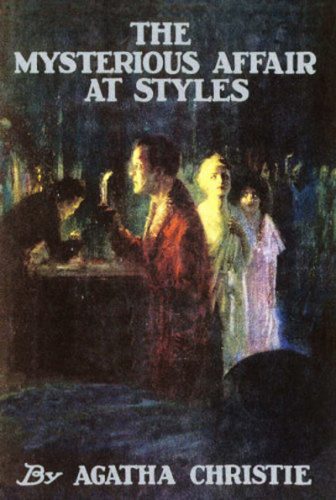
‘Like a good detective story myself,’ remarked Miss Howard.
‘Lots of nonsense written, though. Criminal discovered in last chapter. Every one dumfounded. Real crime – you’d know at once.’
In renowned Belgian detective Hercule Poirot’s debut outing (in novel form, at least), everyone involved thinks they know at once who the killer is, but do they? It seems only Poirot has the intellect and impartiality required to sift the real clues from the red herrings, but can he prevent the wrong man being jailed for murder?
What’s it about?
When wealthy Emily Inglethorp is poisoned, the source of her demise is obvious to those who shared her house and were hoping to share her wealth. Who else could it be but Emily’s new, much disliked and much younger husband, Arthur Inglethorp?
Although…Mrs Inglethorp doesn’t seem to be terribly missed by her two step sons – one of whom insists loudly that all talk of murder and poison is simply ludicrous – or by the dependent young pharmacist who hoped to inherit enough to become independent.
As Poirot investigates, his friend Hastings remains in the house, witnessing all sorts of scenes he has no hope of interpreting accurately and relaying them to his excitable, eccentric friend. Can Poirot solve this mystery? Undoubtedly. Can you?
What’s it like?
‘The Mysterious Affair at Styles’ is cleverly constructed, each chapter contributing something to the final, complicated conclusion.
I enjoyed Poirot’s mysterious comments and exclamations of delight, but found Hastings as a narrator rather frustrating at points. Of course, he cannot be as instantly intelligent as Poirot, or the great detective, with his deep insight into human nature, would be redundant, but often Hastings is simply stupid, proving himself incapable of connecting basic facts or exhibiting normal human curiosity.
Instead, Hastings occasionally develops wildly improbable theories – Mrs Inglethorp believed she was possessed by a devil! – and seems to think of every woman as a possible romantic attachment for himself, which is obviously intended to be amusing, but which I actually found quite off-putting.
Final thoughts
Apparently Agatha Christie wrote this novel in answer to a bet that she couldn’t devise a detective story in which the reader would not be able to spot the murderer, despite having access to the same clues as the detective. Personally, I’m not convinced that the reader did have access to the same clues, but perhaps a 1930s reader would have been aware of certain relevant points which I was unfamiliar with.
I enjoyed reading this and loved the ending. I had an inkling of the answer…but the full truth still came as a delightful shock and I wasn’t initially sure how the murder itself was committed. Fortunately, Poirot is a talker and, ultimately, explained every clue, red herring and careful step in his cunning plan.
I love comprehensive conclusions like this, and look forward to reading many more of Christie’s skilfully constructed mysteries.
‘The Mysterious Affair at Styles’,
Agatha Christie,
2012, HarperCollins, hardback